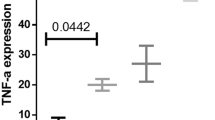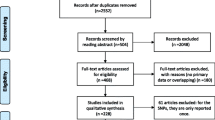Abstract
Tumor necrosis factor-alpha (TNF-α) polymorphisms have been reported to play an important role in the development of cervical cancer. But the results remain inconclusive. We performed this study to provide a comprehensive assessment of the association by means of a meta-analysis in which all published studies were included. The studies investigating the associations between cervical cancer risk and TNF-α polymorphisms were identified through PubMed, Embase, CNKI, and Chinese BioMedical Literature Database. OR and 95 % CI (odds ratio and 95 % confidence interval) were calculated using either the fixed or random effects model to assess the associations. We eventually included eighteen case–control studies of SNP −308 G>A and nine studies of SNP −238 G>A. Meta-analysis of the former polymorphism suggested significantly increased risk of cervical cancer associated with the A allele (OR 1.19, 95 % CI 1.02–1.38). Subgroup analysis according to ethnicity showed similar results in Caucasians (A vs. G: OR 1.25, 95 % CI 1.02–1.54; AA vs. GG: OR 1.47, 95 % CI 1.04–2.08; AA vs. GA+GG: OR 1.47, 95 % CI 1.04–2.08). For SNP −238 G>A, a protective association was observed in overall comparisons (A vs. G: OR 0.64, 95 % CI 0.51–0.80; AA+GA vs. GG: OR 0.62, 95 % CI 0.49–0.79) and subgroup analysis of Caucasians (A vs. G: OR 0.67, 95 % CI 0.53–0.83; AA+GA vs. GG: OR 0.65, 95 % CI 0.51–0.82). Our meta-analysis indicates that TNF-α polymorphisms may confer susceptibility to cervical cancer in an ethic-specific fashion.





Similar content being viewed by others
References
Wank, R., & Thomssen, C. (1991). High risk of squamous cell carcinoma of the cervix for women with HLA-DQw3. Nature, 352(6337), 723–725.
Kuppers, R. (2003). B cells under influence: Transformation of B cells by Epstein-Barr virus. Nature Reviews Immunology, 3(10), 801–812.
Vogelstein, B., & Kinzler, K. W. (2004). Cancer genes and the pathways they control. Nature Medicine, 10(8), 789–799.
zur Hausen, H. (2000). Papillomaviruses causing cancer: Evasion from host-cell control in early events in carcinogenesis. The Journal of the National Cancer Institute, 92(9), 690–698.
Moscicki, A. B., et al. (1998). The natural history of human papillomavirus infection as measured by repeated DNA testing in adolescent and young women. Journal of Pediatrics, 132(2), 277–284.
Luthra, U. K., et al. (1987). Natural history of precancerous and early cancerous lesions of the uterine cervix. Acta Cytologica, 31(3), 226–234.
Bornstein, J., Rahat, M. A., & Abramovici, H. (1995). Etiology of cervical cancer: Current concepts. Obstetrical & Gynecological Survey, 50(2), 146–154.
Dranoff, G. (2004). Cytokines in cancer pathogenesis and cancer therapy. Nature Reviews Cancer, 4(1), 11–22.
Kroeger, K. M., Carville, K. S., & Abraham, L. J. (1997). The -308 tumor necrosis factor-alpha promoter polymorphism effects transcription. Molecular Immunology, 34(5), 391–399.
Hurme, M. (1998). Is susceptibility to infections in the genes? Duodecim, 114(8), 733–734.
Wang, J. M., et al. (1998). Chemokines and their role in tumor growth and metastasis. Journal of Immunological Methods, 220(1–2), 1–17.
Brinkman, B. M., et al. (1995). Relevance of the tumor necrosis factor alpha (TNF alpha) -308 promoter polymorphism in TNF alpha gene regulation. Journal of Inflammation, 46(1), 32–41.
Kroeger, K. M., et al. (2000). Effects of stimulus and cell type on the expression of the -308 tumour necrosis factor promoter polymorphism. Cytokine, 12(2), 110–119.
Eksteen, J. A., et al. (2001). Inflammation promotes Barrett’s metaplasia and cancer: A unique role for TNFalpha. European Journal of Cancer Prevention, 10(2), 163–166.
Chopra, V., Dinh, T. V., & Hannigan, E. V. (1998). Circulating serum levels of cytokines and angiogenic factors in patients with cervical cancer. Cancer Investigation, 16(3), 152–159.
Tjiong, M. Y., et al. (2001). Cytokines in cervicovaginal washing fluid from patients with cervical neoplasia. Cytokine, 14(6), 357–360.
Deshpande, A., et al. (2005). TNF-alpha promoter polymorphisms and susceptibility to human papillomavirus 16-associated cervical cancer. Journal of Infectious Diseases, 191(6), 969–976.
Chen, G., et al. (1996). Tumour necrosis factor-alpha (TNF-alpha) gene polymorphism and expression in pre-eclampsia. Clinical and Experimental Immunology, 104(1), 154–159.
Badano, I., et al. (2012). Analysis of TNFalpha promoter SNPs and the risk of cervical cancer in urban populations of Posadas (Misiones, Argentina). Journal of Clinical Virology, 53(1), 54–59.
Barbisan, G., et al. (2012). TNF-alpha and IL-10 promoter polymorphisms, HPV infection, and cervical cancer risk. Tumour Biology, 33(5), 1549–1556.
Sousa, H., et al. (2014) Tumour necrosis factor alpha 308 G/A is a risk marker for the progression from high-grade lesions to invasive cervical cancer. Tumour Biology, 35(3), 2561–2564.
Jang, W. H., et al. (2001). The -238 tumor necrosis factor-alpha promoter polymorphism is associated with decreased susceptibility to cancers. Cancer Letters, 166(1), 41–46.
Liu, L., et al. (2012). Association between TNF-alpha polymorphisms and cervical cancer risk: A meta-analysis. Molecular Biology Reports, 39(3), 2683–2688.
Pan, F., et al. (2012). Association of TNF-alpha-308 and -238 polymorphisms with risk of cervical cancer: a meta-analysis. Asian Pacific Journal of Cancer Prevention, 13(11), 5777–5783.
Zhang, H. L., & Zhang, Y. J. (2013). A systemic assessment of the association between tumor necrosis factor alpha 308 G/A polymorphism and risk of cervical cancer. Tumour Biology, 34(3), 1659–1665.
Govan, V. A., et al. (2006). The allelic distribution of -308 Tumor Necrosis Factor-alpha gene polymorphism in South African women with cervical cancer and control women. BMC Cancer, 6, 24.
DerSimonian, R., & Laird, N. (1986). Meta-analysis in clinical trials. Controlled Clinical Trials, 7(3), 177–188.
Mantel, N., & Haenszel, W. (1959). Statistical aspects of the analysis of data from retrospective studies of disease. Journal of the National Cancer Institute, 22(4), 719–748.
Egger, M., et al. (1997). Bias in meta-analysis detected by a simple, graphical test. BMJ, 315(7109), 629–634.
Gostout, B. S., et al. (2003). TAP1, TAP2, and HLA-DR2 alleles are predictors of cervical cancer risk. Gynecologic Oncology, 88(3), 326–332.
Kohaar, I., et al. (2007). TNFalpha-308G/A polymorphism as a risk factor for HPV associated cervical cancer in Indian population. Cell Oncology, 29(3), 249–256.
Ivansson, E. L., et al. (2008). MHC loci affecting cervical cancer risk: Distinguishing the effects of HLA-DQB1 and non-HLA genes TNF, LTA, TAP1 and TAP2. Genes and Immunity, 9(7), 613–623.
Singh, H., et al. (2009). Association of TNFA (-308G > A) and IL-10 (-819C > T) promoter polymorphisms with risk of cervical cancer. International Journal of Gynecological Cancer, 19(7), 1190–1194.
Wang, S. S., et al. (2009). Common variants in immune and DNA repair genes and risk for human papillomavirus persistence and progression to cervical cancer. Journal of Infectious Diseases, 199(1), 20–30.
Ivansson, E. L., Juko-Pecirep, I., & Gyllensten, U. B. (2010). Interaction of immunological genes on chromosome 2q33 and IFNG in susceptibility to cervical cancer. Gynecologic Oncology, 116(3), 544–548.
Zu, F. Y., Ai, X., La, L., Wu, S., & Gu, Z. L. (2010). A preliminary study of TNFa gene 308 single nucleotide polymorphism with cervical cancer risk and HPV subtype infection in southern Xinjiang Uygur patients [Article in Chinese]. Chinese Journal of Obstetrics and Gynecology, 45(9), 709–711.
Wang, Q., et al. (2011). Association between cytokine gene polymorphisms and cervical cancer in a Chinese population. European Journal of Obstetrics, Gynecology, and Reproductive Biology, 158(2), 330–333.
Wang, N., et al. (2012). TNF-alpha rs1800629 polymorphism is not associated with HPV infection or cervical cancer in the Chinese population. PLoS One, 7(9), e45246.
Huang, L. L., & Xu, L. (2012). Research of gene polymorphism of cytokines on human papilloma virus induced cervical injury [Article in Chinese]. Journal of Bengbu Medical College, 37(7), 773–783.
Stanczuk, G. A., et al. (2003). Polymorphism at the -308-promoter position of the tumor necrosis factor-alpha (TNF-alpha) gene and cervical cancer. International Journal of Gynecological Cancer, 13(2), 148–153.
Hemminki, K., Dong, C., & Vaittinen, P. (1999). Familial risks in cervical cancer: Is there a hereditary component? International Journal of Cancer, 82(6), 775–781.
Horng, J. T., et al. (2004). Identifying the combination of genetic factors that determine susceptibility to cervical cancer. IEEE Transactions on Information Technology in Biomedicine, 8(1), 59–66.
Wajant, H. (2009). The role of TNF in cancer. Results and Problems in Cell Differentiation, 49, 1–15.
Elahi, M. M., et al. (2009). Tumor necrosis factor alpha -308 gene locus promoter polymorphism: An analysis of association with health and disease. Biochimica et Biophysica Acta, 1792(3), 163–172.
Cabrera, M., et al. (1995). Polymorphism in tumor necrosis factor genes associated with mucocutaneous leishmaniasis. Journal of Experimental Medicine, 182(5), 1259–1264.
Craig, D. W., Mcmullin, E., et al. (1995). Interleukin la and tumor necrosis factor a stimulate autocrine amphiregulin expression and proliferation of human papillomavirus-immortalized and carcinoma-derived cervical epithelial cells. Proc Natl Acad Sci USA, 92, 2840–2844.
Furuta, T., et al. (2002). Interleukin 1beta polymorphisms increase risk of hypochlorhydria and atrophic gastritis and reduce risk of duodenal ulcer recurrence in Japan. Gastroenterology, 123(1), 92–105.
Brinkman, B. M., et al. (1997). Tumour necrosis factor alpha gene polymorphisms in rheumatoid arthritis: Association with susceptibility to, or severity of, disease? British Journal of Rheumatology, 36(5), 516–521.
Hohler, T., et al. (1998). A tumor necrosis factor-alpha (TNF-alpha) promoter polymorphism is associated with chronic hepatitis B infection. Clinical and Experimental Immunology, 111(3), 579–582.
Acknowledgments
Acknowledgement is made to National Natural Science Foundation of China (30970761).
Author information
Authors and Affiliations
Corresponding author
Rights and permissions
About this article
Cite this article
Jin, Y. Association of Single Nucleotide Polymorphisms in Tumor Necrosis Factor-Alpha with Cervical Cancer Susceptibility. Cell Biochem Biophys 71, 77–84 (2015). https://doi.org/10.1007/s12013-014-0165-4
Published:
Issue Date:
DOI: https://doi.org/10.1007/s12013-014-0165-4




